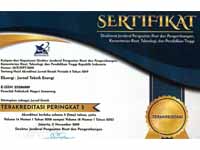Savonius Turbine Performance Type ”“ S Variation of Rotor Sweep Diameter and Air Gap
DOI:
https://doi.org/10.32497/eksergi.v18i2.3582Keywords:
Savonius wind turbine, air gap, power coefficientAbstract
The savonius wind turbine with variations in the diameter of the sweep and the air gap is a technological innovation with treatment using changes in the diameter of the sweep and the distance of the air gap between the blades. And it has low self-starting and relatively high torque. The purpose of the study was to create five models and test the performance of the Savonius wind turbine with variations in sweep diameters of 500 mm, 480 mm, 460 mm, 440 mm and 420 mm with air gaps of 30 mm, 50 mm, 70 mm, 90 mm, and 110 mm. . And analyze the turbine performance to get the best Coefficient of Power (CP) from the five turbine gaps. The stages of the research method include the preparation of a literature search, turbine design planning, tool making, tool testing, data collection, data analysis, and the final stage. The results of the tests carried out showed that the Savonius turbine with an air gap of 70 mm with a CP value of 0.232 had maximum work at low wind speeds (4 m/s) and at high wind speeds (10 m/s). obtained a CP value of 0.0695
References
.”¦, 2008. Potensi Energi Angin Indonesia.
https://p3tkebt.esdm.go.id/piot-plan-project/ energi_angin/
potensienergi-angin-indonesia-2020.(12 Februari 2021).
(Internet
Habibie, M. Najib, dkk. 2011. Kajian Potensi Angin
di Wilayah Sulawesi dan Maluku. Jakarta : Puslitbang BMKH
Alit, dkk. 2016. Turbin Angin Poros Vertikal Tipe
Savonius Bertingkat dengan Variasi Posisi Sudut. Mataram:
Dinamika Teknik Mesin 6 (2016) 107-112.
Taher, G., dkk. 2014. Investigation of the
Aerodynamic Performance of Darrieus Vertical Axis Wind
Turbine.IOSR Journal of Engineering. Vol(04), Issue 05.
Rizkiyanto, S. dkk. 2015. Perancangan Turbin Angin
Tipe Savonius Dua Tingkat Dengan Kapasitas 100 Watt untuk
GedungSyariah Hotel Solo. Universitas Sebelas Maret: Jurnal
MEKANIKA Volume 14 Nomor 1.
Soelaiman, F., Tandian, Nathanael P., danRosidin, N.,
Perancangan, Pembuatan dan Pengujian Prototipe SKEA
Menggunakan Rotor Savonius dan Wind side untuk Penerangan
JalanTol. Bandung: ITB
Rizkiyanto, S. dkk. 2015. Perancangan Turbin Angin
Tipe Savonius Dua Tingkat Dengan Kapasitas 100 Watt
untukGedung Syariah Hotel Solo. Universitas Sebelas Maret:
Jurnal MEKANIKA Volume 14 Nomor 1.
Lysen, E. H, 1983. Introduction to Wind Energy,
Basic and Advance Introduction to Wind Energy With Emphasis
on Water Pumping Windmills. Development Cooperation
Departement. Netherland.
MeldaLatif. 2013. Efesiensi Prototipe Turbin
Savonius pada Kecepatan Angin Rendah. Jurnal Rekayasa
Elektrika Vol. 10, No. 3, Fakultas Teknik, Universitas Andalas
Padang.
Ambrosio, M. Megdalia, M. 2010. Vertical Axis Wind
Turbines: History, Technology and Application.Jonny Hylander
and GoranSiden, Swedia.
Lysen, E. H, 1983. Introduction to Wind Energy,
Basic and Advance Introductionto Wind Energy With Emphasis
on Water Pumping Windmills.Development Cooperation
Departement. Netherland.
Sularso dan Kiyokatsu S. 1994. Dasar perencanaan
dan pemilihan elemen mesin. Pradnyapramita: Jakarta.Manfred
Stiebler.
Maldonado, R.D. 2013. Design, Simulation and
Construction of a Savonius Wind Rotor For Subsidized Houses in
Mexico. ISES Solar World Congress.
Hamdi, ron (2015) Pengaruh Variasi Diameter Dan
Jumlah Sudu Pada Turbin Angin Poros Vertikal Tipe Savonius
Terhadap Unjuk Kerja. S1 thesis, Universitas Mataram.
http://eprints.unram.ac.id/id/eprint/5284
Jamal, Jamal and A. M. Shiddiq, Yunus and Lewi,
Lewi (2019) Pengaruh Kelengkungan Sudu Terhadap Kinerja
Turbin Angin Savonius. Intek (Informasi Teknologi) Jurnal
Penelitian, 6 (2). pp. 139- 144 . ISSN 2339 -0700.
Downloads
Published
Issue
Section
License
Authors who publish with this journal agree to the following terms:Authors retain copyright and grant the journal right of first publication with the work simultaneously licensed under a Creative Commons Attribution License that allows others to share the work with an acknowledgement of the work's authorship and initial publication in this journal.
Authors are able to enter into separate, additional contractual arrangements for the non-exclusive distribution of the journal's published version of the work (e.g., post it to an institutional repository or publish it in a book), with an acknowledgement of its initial publication in this journal.
Authors are permitted and encouraged to post their work online (e.g., in institutional repositories or on their website) prior to and during the submission process, as it can lead to productive exchanges, as well as earlier and greater citation of published work (See The Effect of Open Access).






